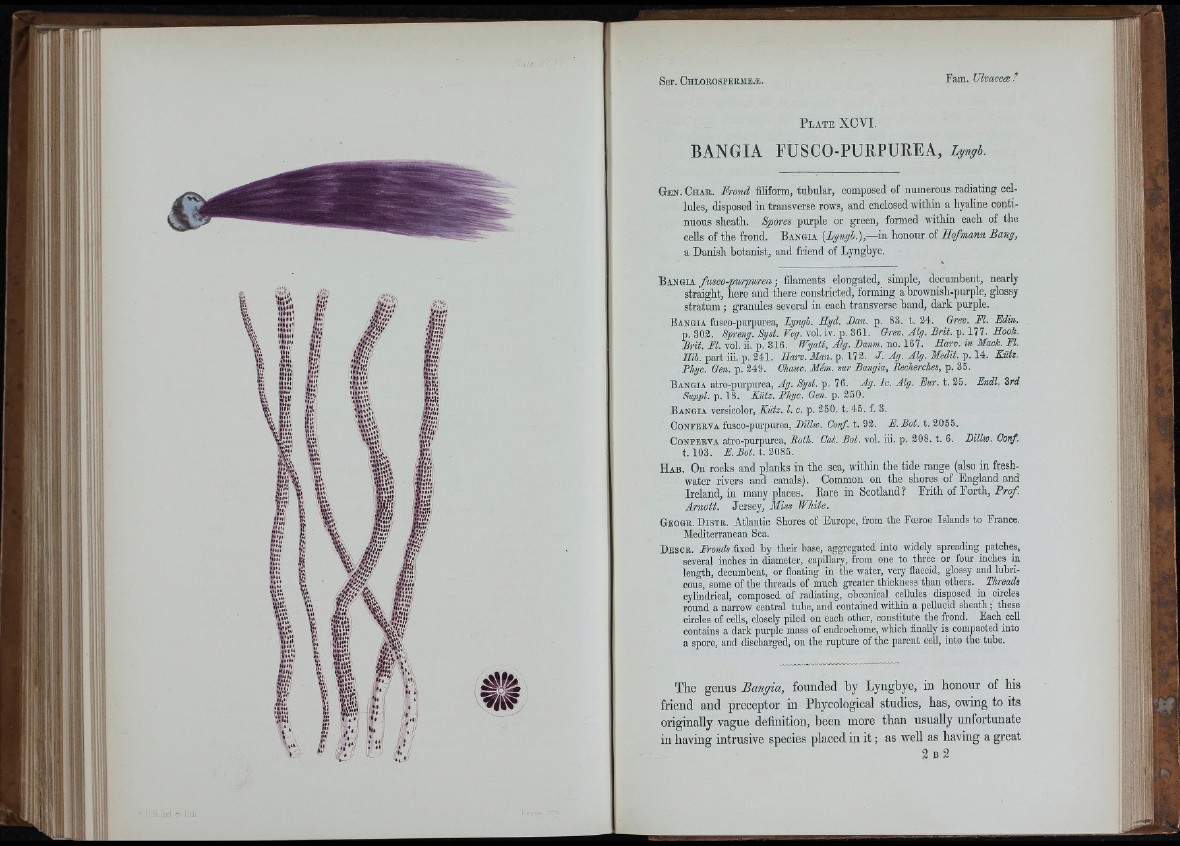
¡yi
v w
. S i !
P la t e XCVI.
BANGIA FUSCO-PURPUREA, Lyngb.
Gen. Chae. Frond filiform, tubular, composed of numerous radiating cellules,
disposed in transverse rows, and enclosed within a hyaline continuous
sheath. Spores purple or green, formed within each of the
ceRs of the frond. B a n g ia {Lyngb.),— m honour of Hofmann Bang,
a Danish botanist, and friend of Lyngbye.
Bangia fusco-purpurea; filaments elongated, simple, decumbent, nearly
straight, here and there constricted, forming a brownish-purple, glossy
stratum ; granules several in each transverse band, dark purple.
Bangia fusco-purpurea, Lyngh. Hyd. Ban. p. 83. t. 34. Grev. El. Edin.
p. 303. Spreng. Syst. Veg. vol. iv. p. 361. Grev. Alg. Brit. p. 177. Hoole.
Brit. El. vol. ii. p. 316. Wyatt, Alg. Banm. no. 167. Harv. in Mack. El.
ffiS. part iii. p. 241. Harv. M a n .q .\1 2 . J. Ag. Alg. Medit. p . 14. Kutz.
Phyc. Gen. p. 249. Chauv. Mém. sur Bangia, Mecherches, p. 3S,
Bangia atro-pm-piu-ea, Ag. Syst. p. 76. Ag. Ic. Alg. Eur. t. 25. Ekdl. 3rd
Suppl. p. 18. Kiitz. Phyc. Gen. p. 250.
Bangia versicolor, Kiitz. I. c. p. 250. t. 45. f. 3.
CoNEERVA fusco-purpurea, Billw. Conf. t. 92. E .Bot. t. 2055.
C o n e e b t a a tro -p u rp u re a , Both. Cat. Bot. vol. iii. p . 2 0 8 . t . 6. Billw. Conf.
1 . 1 0 3 . E.Bot.t.%3%5.
H ab. On rooks and planks in the sea, within the tide range (also in freshwater
rivers and canals). Common on the shores of England and
Ireland, in many places. Rare in Scotland? Frith of Forth, Prfyi
Arnott. Jersey, Miss White.
Geogr. Distr. Atlantic Shores of Europe, from the Foeroe Islands to France.
Mediterranean Sea.
Desor. Eronds fixed hy their base, aggregated into widely spreading patches,
several inches in diameter, capiUary, from one to three or four inches in
length, decumbent, or floating in the water, very flaccid, glossy and lubricous,
some of the threads of much gi-eater thickness than others. Threads
cylindrical, composed of radiating, obconical cellules disposed in circles
round a narrow central tube, and contained within a pefiucid sheath ; these
circles of cells, closely piled on each other, constitute the frond. Each cell
contains a dark purple mass of endrochome, which finally is compacted into
a spore, and discharged, on the rupture of the parent cell, into the tube.
The genus Bangia, founded by Lyngbye, in honour of his
friend and preceptor in Phycological studies, has, owing to its
originally vague definition, been more tban usually unfortunate
in having intrusive species placed in i t ; as well as having a great
2 b 2
- ■!?1
i"|-l ..I! I
i f
' ;> I
' 4
1 1
' rl: